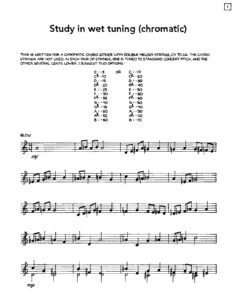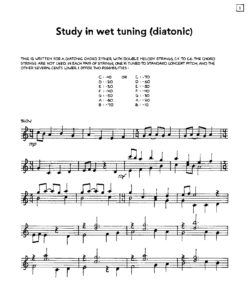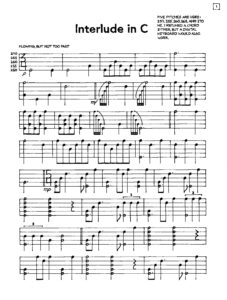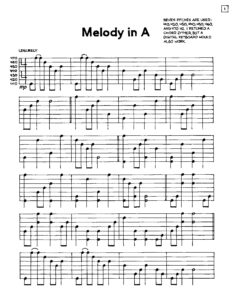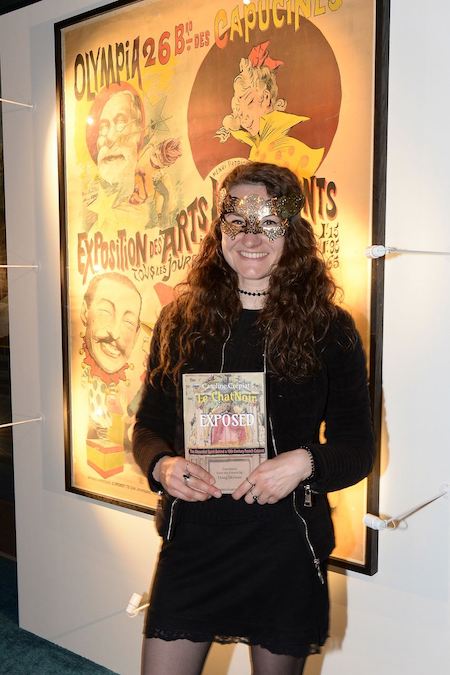Here’s another study in wet tuning, the practice of slightly detuning two pitches to give a richer sound. It’s often used in accordions. Here, I detune double melody strings on a chord zither. As in the diatonic study, I offer two possibilities.
Study in wet tuning (chromatic)
June 13th, 2022 · Comments Off on Study in wet tuning (chromatic)
Comments Off on Study in wet tuning (chromatic)Tags: *Music · S
Study in wet tuning (diatonic)
June 6th, 2022 · Comments Off on Study in wet tuning (diatonic)
Wet tuning is the practice of slightly detuning two pitches to give a richer sound. It’s often used in accordions. Here, I detune double melody strings on a chord zither. And I offer two possibilities.
Comments Off on Study in wet tuning (diatonic)Tags: *Music · S
Interlude in C
May 29th, 2022 · 2 Comments
This interlude uses five pitches around middle C: 250, 255, 260, 265, and 27o Hz. I retuned a chord zither, but a digital keyboard would also work.
→ 2 CommentsTags: *Music · I
Black Scat Review 25
May 23rd, 2022 · 2 Comments
The 25th issue of Black Scat Review is now out and ready for you to read! This one is subtitled “Lewd, Nude, and Rude,” and contains three of my contributions: “King Merrimack,” in which the eponymous monarch and his physician Celso receive a boorish visitor; “The Noble Apothecary,” my translation of a 1664 novella by Jean Donneau de Visé, concerning love, jealousy, and enemas; and “English Etiquette,” my translation of a brief passage from Casanova on the finer points of relieving oneself in public.
You can also savor the work of Mark Axelrod, Thomas Barrett, Sebastian Bennett, Norman Conquest, R J Dent, Dawn Avril Fitzroy, Eckhard Gerdes, Alexander Krivitskiy, Amy Kurman, Hélène Lavelle, Marc Levy, Olchar E. Lindsann, Clément Marot, Lilianne Milgrom, Alison Miller, T. Motley, Angelo Pastormerlo, Gerard Sarnat, Valéry Soers, Gregory Wallace, Tom Whalen, and David Williams. The whole thing is edited and designed by Norman Conquest (with contributing editors Farewell Debut and Nile Southern), and is available on Amazon.
→ 2 CommentsTags: *Words · B
Music for Two Monochords: Sixes and Sevens
May 15th, 2022 · 2 Comments
Two monochords play a duet: one plays segments of the string that are divisible by six, the other segments that are divisible by seven. All ends harmoniously on 84.
→ 2 CommentsTags: *Music · M
Melody in A
May 10th, 2022 · Comments Off on Melody in A
Seven pitches are used: 410, 420, 430, 440, 450, 460, and 470 Hz. I retuned a chord zither, but a digital keyboard would also work. Here’s the first page:
Comments Off on Melody in ATags: *Music · M
Caroline Crépiat with “Le Chat Noir Exposed”
May 5th, 2022 · Comments Off on Caroline Crépiat with “Le Chat Noir Exposed”
Caroline Crépiat holds up my translation of her book Le Chat Noir Exposed, at an art show in Paris.
If you haven’t read it yet, this may remind you that you’ve been meaning to.
Comments Off on Caroline Crépiat with “Le Chat Noir Exposed”Tags: *Words · C
Gegenschein
April 24th, 2022 · Comments Off on Gegenschein
A quiet sonic glimmer for glockenspiel or vibraphone and piano, dodecaphonic but not exactly serial.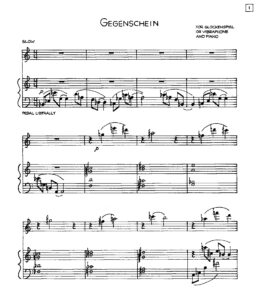
Comments Off on GegenscheinTags: *Music · G
Index Cards (105)
April 21st, 2022 · Comments Off on Index Cards (105)
Comments Off on Index Cards (105)Tags: *Index Cards
The Somethingization of Something
April 13th, 2022 · Comments Off on The Somethingization of Something
This sad little tale can be found in The Snowman Three Doors Down. The title did, in fact, come from a dream. The constraint (for there is a constraint) is that the text forms an acrostic of the title, and that each sentence contains the number of words corresponding to the initial letter’s place in the alphabet.
THE SOMETHINGIZATION OF SOMETHING
That curious phrase, “the somethingization of something,” which I had heard in a dream, continued to prey on my mind.
However I considered it, it still troubled me.
Everything about it was elusive.
Several weeks had passed since I dreamed it, and, try as I might, I could not remember the context.
Only those four words remained, the dream itself having long since evaporated from my memory.
My heart sank every time I contemplated it, and I contemplated it often.
Eventually I had had enough.
The only way to put my mind at ease was to make that maddeningly elusive phrase tangible in some way.
Having reached that conclusion, I set to work.
I sawed large letters from a plank of plywood.
Nothing could be more material than plywood letters, I thought, and nothing less nebulous.
Great big sturdy plywood letters!
In less than an hour, my work was done.
Zigzagging over the lawn, spelling the phrase, I reached a tree, which I climbed to survey my work, and then toppled from onto the fifteenth letter.
A.
That had to be the letter that broke my fall, of course: the one with the sharp point sticking up.
I had to admit that it was unequivocally tangible.
Of course, I would have preferred that it manifest substantiality in some less painful way.
Nevertheless, I staggered to my feet, extracted the bloodstained letter, and stanched my cut.
Once the bleeding stopped, I turned to examine the phrase, and tripped over an O.
Fortunately, Os are not sharp letters.
Sadly, however, my right leg became stuck in it, and I scraped myself badly when I pulled it off.
Onward I stumbled until, to my dismay, I tripped again, and fell over another O.
My left leg caught this time, and its extraction was no less painful.
Eventually, I surveyed my handiwork.
Then I pitched forward onto my face, as a sudden earthquake sent my phrase clattering down the hill in confusion.
Heartsick, I watched the palpable jumble into unintelligibility.
It was a disappointing end to my intended solution.
Nothing survived my engagement with the elusive, or my attempt at clarification, but gibberish.
Gibberish was not what I had wanted.
Comments Off on The Somethingization of SomethingTags: *Words · S

